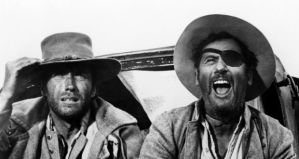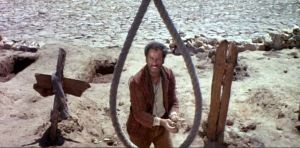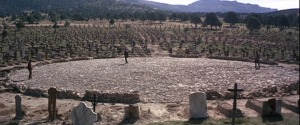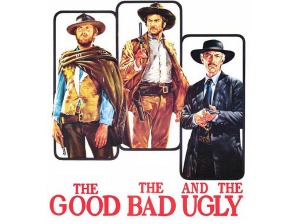This pick is a bit more personal than the last three films on this countdown. By that, I mean that I can accurately describe why films like "Seven" and "Mr. Smith Goes To Washington" deserve to be here in full detail and give you guys a good idea of how I feel about that film. Not so much with this one.
Why? Because my feelings on this film can be summarized up in four words - It is kick-ass. But let's try to be more descriptive than that, shall we?
I've never been great at picking a favorite genre of cinema. For a long time, it was giant monster films, then science fiction, followed by film noir, thrillers, over to animated, and recently to a streak of epics. But when I started to gain a deep interest in cinema, one of the films that I first watched was "Once Upon A Time In The West," an insanely long and padded western by the great Italian director Sergio Leone.

At that point, I became hooked on westerns. The idea of the hero in a place that did not deserve a hero. Where even the good guys had a crooked sense of morality and ethics. The tales of a time long since passed by law, order and society.
Westerns were as artistically pleasing as they were entertaining.
I bring this up because, like most people do with certain genres, when I think of westerns, there is always one movie that sticks out and reminds me how awesome and captivating the old west was - Sergio Leone's 1966 film "The Good, The Bad And The Ugly." To me, that is the quintessential western on how to create eternal characters in a world of everlasting violence and greed.
The strange thing is that "The Good, The Bad And The Ugly" wasn't even shot in America. Most of it was filmed in Spain by an Italian film crew. Yet it never once feels like anything more than an American product.
It is the middle of the Civil War, and it is not looking pretty for either side. But in the middle of all this chaos and waste of life, word gets out about a hidden cash box, buried deep in a cemetary, worth over $200,000. Through pure coincidence and word of mouth, three drastically different people hear about the gold - The hired gun who "always sees his job through," also known as Angel Eyes "The Bad" (Lee Van Cleef), the double-crossing Tuco who is only out for himself and his interests "The Ugly" (Eli Wallach), and the man with no name but never misses a shot "The Good" (Clint Eastwood). Now all three must work their way to the gold, through both sides of the war, as well as anyone who might get in their way.

Everything we need to know about these characters is given to us from the start, and not just because of their names. Tuco is ambushed by three unknown guns, supposedly after the massive bounty on his head, but gets away with a turkey leg in hand and leaves the others to die.
Angel Eyes interrogates a family man for information that he was paid to get, and then murders him, but only after the man gave Angel Eyes even more money to kill the sick old man who wanted that information in the first place. Which he does, gladly.

The Man With No Name (or "Blondie" as Tuco calls him), brings Tuco into the authorities to collect the reward money, and promptly save him from being hung by shooting the noose, then gives Tuco half of the reward money so that they can do it all over again. But when Blondie thinks that Tuco's bounty has reached its highest point, he cuts Tuco loose. Of course, he can't bring himself to kill Tuco "after all the times he saved him" so he leaves Tuco stranded in the middle of the desert.
But Blondie probably didn't count on Tuco surviving the long walk from that barren wasteland into the nearest town. And now Tuco wants revenge.
"If you are going to miss (the noose), you had better miss well," says Tuco at one point. "Because whoever double-crosses me and leaves me alive, he knows nothing about Tuco. Nothing."
From that point on, we have three characters who are charming in their own unique way, yet so different enough that you want to see more of how they'll interact with each other. Just what does Tuco have in mind for revenge? Can he even catch Blondie? How does Angel Eyes figure into all of this? Have these three had a history together? All of these questions are buzzing in my head and they are all answered.

And all this time, they are in the center of the civil war. We see more of the aftermath of this conflict than the battles, which helps to paint a picture of this world of confusion, hatred and self-interest. This serves as an amazing backdrop to an already classic western story of revenge, treasure-seeking and backstabbing.
One scene that helps to elevate "The Good, The Bad And The Ugly" above most westerns is one that could have cut entirely. Tuco has just escaped and is on the trail of Blondie and Angel Eyes, but he's decided to stop in at a house that has nearly been reduced to rubble to take a bath. But a man who had been wronged by Tuco spots him and follows Tuco inside, where the one-armed man confronts Tuco while he is in the tub and leads to a hilarious moment in the film.
From a certain point of view, this scene didn't need to be in the film. It doesn't add anything to the narrative and goes on for some time, longer than it needed to. But it adds a new level of atmosphere to the film, to remind us of this big world out there and that Tuco has done some pretty terrible things. The film is stopping for a moment to let the audience sit back and appreciate what it has to offer. To let the audience breath and take in the surroundings.
Little moments like that can go a long way.
But upon my most recent viewing of "The Good, The Bad And The Ugly" something occurred to me while I watched many sun-scortched faces stare into the camera as they prepare for a showdown, or how Angel Eyes is half way through a meal before he says anything - This is a story of images and not words. Any words exchanged are very brief and necessary. Everything else is done visually and through the vast Spanish landscape.
There are very few westerns that can say that they let a bridge explain more about a film than a long monologue.
This is best shown through the greatest scene in the film - the final standoff. All three characters have gathered at the cemetery, ready to collect the gold, and none of them are keen on sharing it. Without ever saying a word, an epic showdown is performed through expert editing and a heart-pounding score by Ennio Morricone. As the scene progresses, the camera gets closer and closer to the character's faces and we can see Tuco's face turn from confidence to fear, as well as Angel Eyes thinking about pulling his gun at the right moment.

So much is said, without ever saying a word.
To pull off something like that takes a lot of passion and imagination. The same kind of imagination that would set a western gold hunt in the middle of the civil war. The kind of passion that would take the time to develop its main characters so accurately and without saying more than a few sentences. The kind of imagination that would have its climax be shot through close-ups of actors staring into the camera.
In the hands of anyone else, "The Good, The Bad And The Ugly" probably would not work. But Sergio Leone had just the right mix of character development, western homage, creative settings, cinematic technique, passion and an "always go big" attitude to pull off something like this. And in the end, Leone gave us one of the greatest westerns of all time.


No comments:
Post a Comment